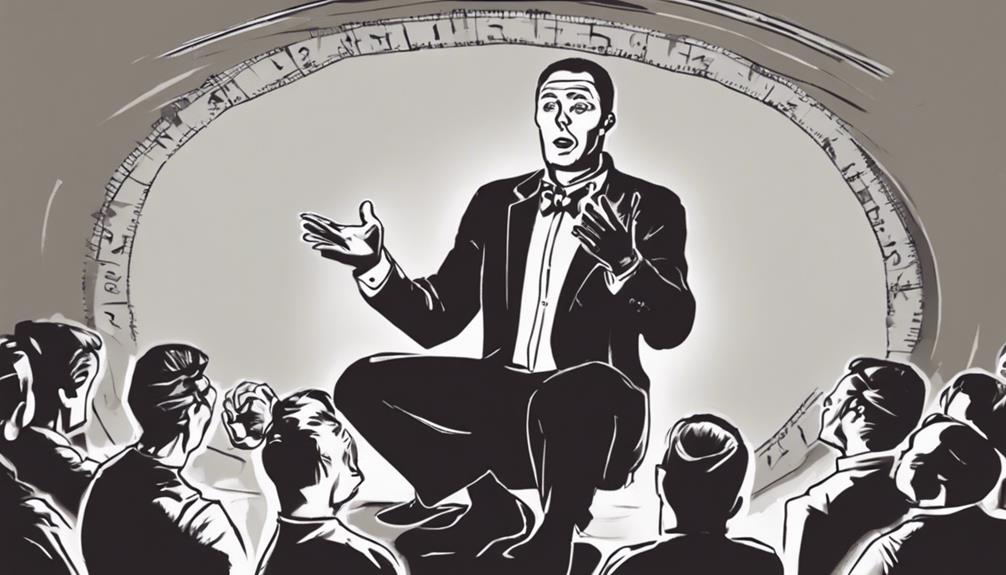Utilize advanced covert hypnosis techniques to intricately influence subconscious thoughts and behaviors. These methods enable a fine line between manipulation and persuasion, emphasizing the power of suggestion and imagery. By bypassing conscious resistance, one can effectively tailor messages to align with the subject's desires. Mastering nonverbal cues and understanding power dynamics enhance communication skills and establish authority. Building trust through rapport, aligning with beliefs, and conveying authenticity aids in positive behavior influence. Subtle behavior modifications and tailored suggestions achieve desired outcomes by tapping into deep-seated desires. Delving further into psychological insights and ethical considerations maximizes the potential of covert hypnosis techniques.
Benefits of Advanced Covert Hypnosis

Exploring the benefits of advanced covert hypnosis reveals its potential to influence subconscious thoughts and behaviors with remarkable subtlety and effectiveness. When discussing manipulation vs. persuasion in the context of covert hypnosis, it is essential to understand that manipulation involves exerting control over others for personal gain, while persuasion aims to influence choices beneficial to all parties involved.
Advanced covert hypnosis techniques focus on subtle subconscious influence, emphasizing the power of suggestion and mental imagery to shape behavior without the subject's awareness.
The ability to tap into the subconscious mind allows for a deeper level of influence compared to overt communication methods. By bypassing conscious resistance, covert hypnosis can plant suggestions that guide decision-making processes without triggering defensive reactions. This approach enables practitioners to tailor their messages to align with the subject's desires and beliefs, increasing the likelihood of compliance and cooperation.
Enhancing Communication Skills
To effectively utilize advanced covert hypnosis techniques, mastering the art of enhancing communication skills is paramount. Communication involves not only the words spoken but also the nonverbal cues that can significantly impact the message being conveyed. Understanding and interpreting nonverbal cues such as body language, facial expressions, and tone of voice can help a practitioner of covert hypnosis establish a deeper connection with their subject and tailor their approach accordingly.
Moreover, power dynamics play a crucial role in communication. Being aware of power differentials in a conversation can help the hypnotist navigate interactions more effectively. By understanding power dynamics, the practitioner can adjust their language, tone, and demeanor to establish authority and influence over the subject subtly.
Incorporating these aspects into the practice of covert hypnosis can enhance the hypnotist's ability to communicate persuasively and achieve desired outcomes. Mastering communication skills, including interpreting nonverbal cues and navigating power dynamics, is essential for successful implementation of advanced covert hypnosis techniques.
Building Trust and Rapport

Establishing a strong foundation of trust and rapport is fundamental in the practice of advanced covert hypnosis, as it forms the basis for effective communication and influence.
In the realm of covert hypnosis, the ability to establish connection and build relationships is crucial for gaining the trust of the individual you are communicating with. Creating rapport, which involves mirroring body language, tone of voice, and language patterns, is a powerful technique to enhance trust and deepen the bond between the hypnotist and the subject.
Building trust through covert hypnosis involves not only verbal communication but also non-verbal cues that convey sincerity and authenticity. By aligning with the subject's beliefs, values, and emotions, the hypnotist can establish a sense of understanding and empathy, further solidifying the bond of trust.
This trust forms the basis for influencing behavior positively, as individuals are more likely to be receptive to suggestions from someone they trust and feel a connection with. In essence, mastering the art of building trust and rapport is a cornerstone of successful covert hypnosis practices.
Influencing Behavior Positively
The effective influence of behavior in covert hypnosis hinges on the strategic alignment of suggestions with the individual's subconscious desires and motivations. Behavior modification through covert hypnosis involves tapping into the subconscious mind to instigate positive changes in behavior patterns.
By influencing the subconscious mind, practitioners can guide individuals towards adopting new attitudes, habits, and responses.
Subconscious influence plays a crucial role in shaping behavior positively. Through subtle suggestions and language patterns, covert hypnosis can bypass conscious resistance and directly impact the subconscious, leading to lasting behavioral changes.
When the suggestions provided align with the individual's deep-seated desires and motivations, the likelihood of successful behavior modification increases significantly.
Covert hypnosis techniques offer a unique approach to influencing behavior by working on a subconscious level. By understanding the intricacies of the subconscious mind and tailoring suggestions accordingly, practitioners can help individuals overcome obstacles, adopt healthier habits, and enhance their overall well-being.
This targeted approach to behavior modification sets covert hypnosis apart as a powerful tool for facilitating positive change.
Achieving Desired Outcomes

In covert hypnosis, achieving desired outcomes relies on the precise alignment of suggestions with the individual's subconscious inclinations and objectives.
When it comes to improving relationships through covert hypnosis, understanding the underlying motivations and needs of the individuals involved is crucial. By tailoring suggestions to enhance communication, empathy, and mutual understanding, covert hypnosis can facilitate stronger connections and more harmonious interactions.
Similarly, in the context of reaching goals, covert hypnosis can be a powerful tool for influencing behavior towards desired outcomes. By embedding suggestions that promote motivation, determination, and focus, individuals can be guided towards taking actions that align with their objectives. This can lead to increased productivity, enhanced performance, and a greater likelihood of achieving success in various areas of life.
In essence, the effectiveness of covert hypnosis in achieving desired outcomes lies in its ability to tap into the subconscious mind and influence behavior in a way that is conducive to improving relationships and reaching goals.
Gaining Psychological Insights
Gaining psychological insights is fundamental to the strategic application of covert hypnosis techniques in understanding and influencing human behavior. To effectively utilize advanced covert hypnosis, one must delve into the intricacies of human psychology, focusing on understanding motives and emotions. By deciphering the underlying reasons driving individual actions, a practitioner can tailor their hypnotic approach to resonate with the subject on a deeper level.
Moreover, reading body language and cues plays a pivotal role in gaining psychological insights during covert hypnosis. Non-verbal communication can reveal a wealth of information about a person's mindset and feelings, offering valuable cues for the hypnotist to adjust their techniques accordingly. Recognizing subtle gestures, facial expressions, and posture can provide essential clues about the subject's receptiveness to suggestions and help in gauging the overall effectiveness of the hypnosis session.
In essence, gaining psychological insights through understanding motives, emotions, and reading body language is crucial for successfully applying advanced covert hypnosis techniques to influence human behavior with precision and efficacy.
Ethical Considerations in Hypnosis

Understanding and adhering to ethical principles is paramount when engaging in the practice of hypnosis, ensuring the well-being and autonomy of individuals involved in hypnotic interactions. Professional boundaries play a crucial role in maintaining the integrity of the therapeutic relationship between the hypnotist and the client. It is essential for the hypnotist to establish clear boundaries to prevent any misuse of power dynamics and to uphold the trust placed in them by the client.
Client consent is another fundamental aspect of ethical considerations in hypnosis. Before initiating any hypnotic session, the client must provide informed consent, understanding the nature of the process, potential outcomes, and their right to withdraw at any point. This ensures that the client participates in the hypnosis voluntarily and without coercion, safeguarding their autonomy and well-being throughout the session.
Moreover, ethical considerations in hypnosis also involve grappling with the moral implications of influencing individuals' thoughts and behaviors. Hypnotists must navigate these ethical dilemmas with sensitivity and respect, always prioritizing the best interests of the client within the boundaries of the therapeutic relationship.
Frequently Asked Questions
Can Advanced Covert Hypnosis Be Used for Self-Improvement?
Advanced covert hypnosis techniques can be utilized for self-improvement by influencing subconscious behaviors and beliefs. Through tailored suggestions and strategies, individuals can address personal growth areas, enhance self-awareness, and facilitate positive change in various aspects of their lives.
How Can One Differentiate Between Covert Hypnosis and Manipulation?
Differentiating covert hypnosis from manipulation involves assessing the ethical aspect of intent versus influence. Covert hypnosis is subtle persuasion with the intention to empower, while manipulation seeks to control for personal gain. Understanding motives is key.
Are There Risks Involved in Using Advanced Covert Hypnosis Techniques?
When employing advanced covert hypnosis techniques, it is crucial to acknowledge potential dangers such as unintended consequences, manipulation, and breaches of ethical boundaries. Understanding and adhering to ethical considerations are paramount to mitigate risks effectively.
Can Covert Hypnosis Techniques Be Used in Professional Settings?
In professional settings, covert hypnosis techniques can be utilized for workplace influence within ethical boundaries. Understanding persuasion tactics and enhancing communication skills are essential in leveraging such methods effectively and responsibly to achieve desired outcomes.
How Long Does It Take to Master Advanced Covert Hypnosis Techniques?
Mastering advanced covert hypnosis techniques requires a significant time commitment. The duration varies depending on individual aptitude and dedication. Generally, a solid grasp of these techniques can be achieved through consistent practice and study over several months to years.
Conclusion
In conclusion, the utilization of advanced covert hypnosis techniques offers numerous benefits, including:
- Enhancing communication skills
- Building trust and rapport
- Positively influencing behavior
- Achieving desired outcomes
- Gaining psychological insights
It is important to consider ethical considerations when using hypnosis in order to ensure that it is being used in a responsible and respectful manner.
Overall, advanced covert hypnosis techniques can be a valuable tool for individuals seeking to improve their communication and persuasion abilities.

















